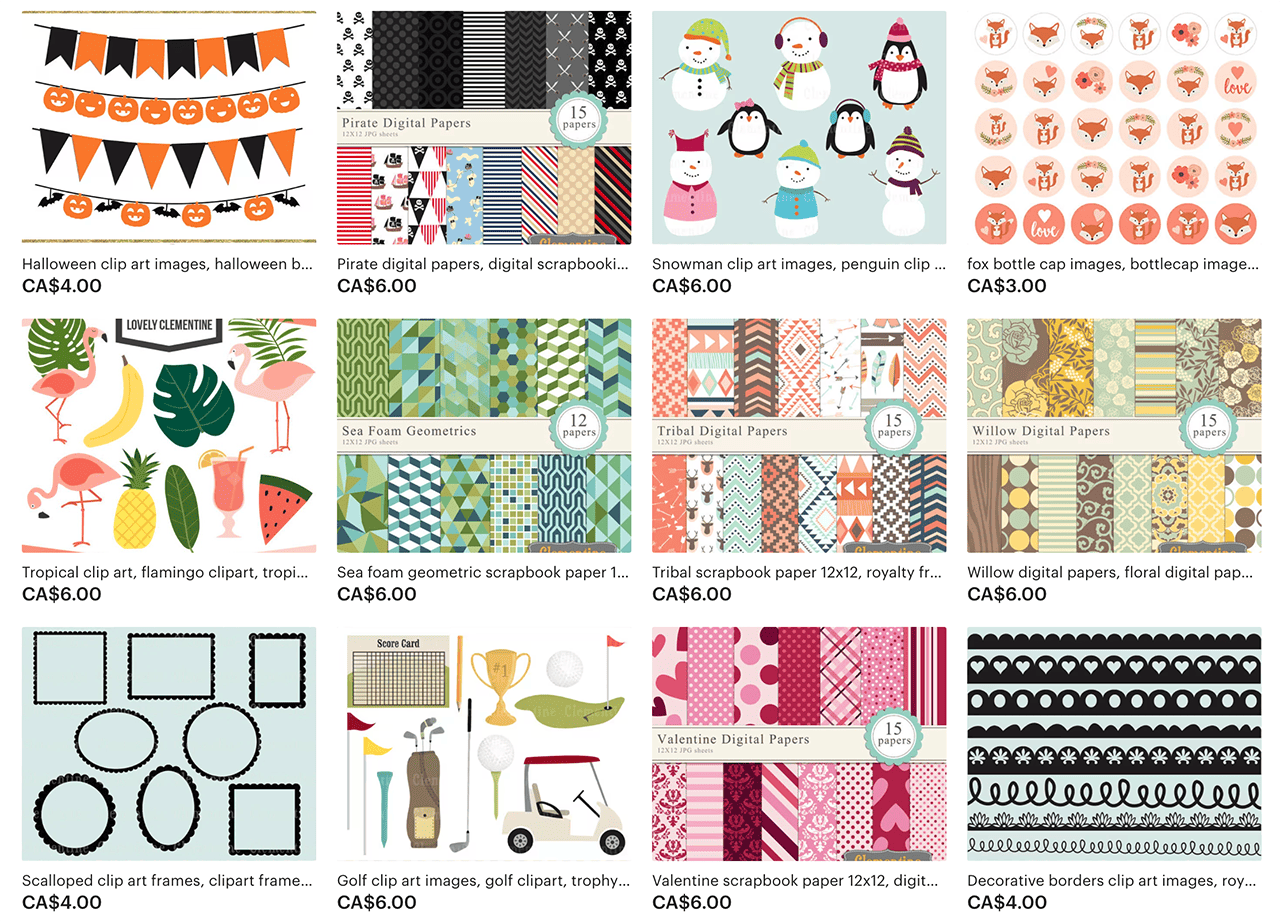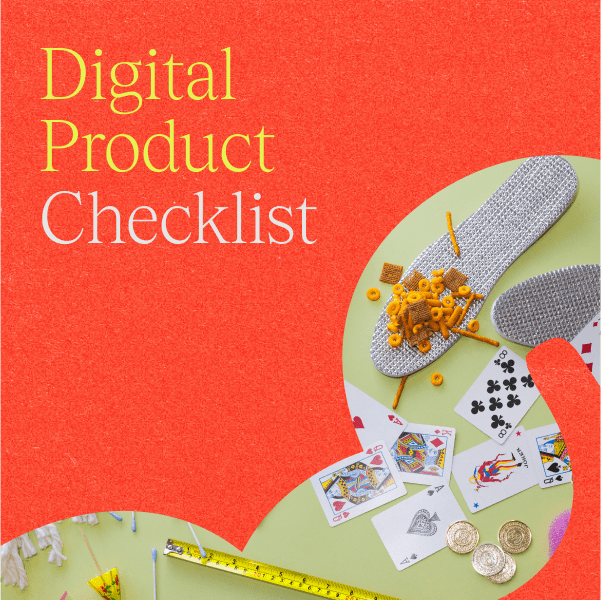We’re entering the era of digital products — from ebooks to online courses, creators of all kinds are raking in the dough through selling digital products. It’s quickly becoming one of the most popular — and most profitable — ways for creators to earn a living. Sounds too good to be true? Just check out the stats: the digital media market is set to reach $499 billion by the end of 2023. That’s a massive pie!
Interested in earning a slice? You might be wondering, “What exactly is a digital product?”, “What kinds of digital products can I sell online?”, or, better yet, “Which digital products are the most profitable?” Well, look no further. For those looking to create and earn money from digital products, this handy guide provides you with examples of some of the most profitable and easy-to-create digital products, as well as how and where you can start selling them, today. Let’s get into it.
New to selling digital products? Download our free Digital Product Launch Checklist for tips to start on the right foot!
What are digital products?
First, let’s cover the basics. A digital product is anything you can sell online as a downloadable file. This includes templates (think CV templates, wedding invite templates, contract templates), ebooks (like digital cookbooks and study guides), online courses, website themes, stock music, downloadable art prints, fonts, craft pattern PDFs — the list goes on.
Essentially, if you can dream it and download it, it’s a digital product — and you can sell it online.
The benefits of selling digital products
In addition to the over-$600-billion digital media pie, there are a number of other compelling reasons you might want to get into the digital product game, including:
Low production costs

First, selling digital products requires relatively little investment compared to selling physical products. This is because digital products are primarily created and sold using digital tools, which are much more affordable than the physical tools required to make, sell, and store tangible merchandise.
For example, to sell physical goods, traditionally, you’d need to rent a brick-and-mortar location to sell from and a warehouse to store your merchandise.
When it comes to digital products, there’s no need for a store or an inventory — at least, not in the traditional sense. Rather than IRL, digital products are sold online. Creators can sell digital products through a myriad of places, including a website, an online storefront, a digital marketplace, or micro-solutions like online shopping carts.
To do this, sellers typically pay to use their e-commerce platform of choice, either by monthly subscription or by paying a commission of each sale made. Many of these e-commerce platforms will also host your digital products for you at no additional cost. When you add it all up, the costs come to significantly less than what you’d be investing in for selling physical products.
Higher profit margins than physical products

When it comes to creating and selling physical merchandise, sellers also need to invest significant time and money in maintaining a physical inventory. This just doesn’t apply to digital products. And not only does this fact save you money, it actually makes you money.
Because a digital product is essentially a downloadable file, it only needs to be produced once. From there, your customers can download copies, over and over. That means you don’t need to invest money or energy producing more units. It also means that you can expect higher returns on selling digital products over selling physical products, with a profit margin that improves over time.
No shipping logistics

By now, you might be wondering, “How will my customers receive my digital product once they purchase it?”
In a nutshell, a customer downloads a copy of your digital product directly and instantly to their computer or device. Most e-commerce platforms will provide customers with a unique download link (usually via email) once they’ve made their purchase. In other words, no one involved needs to deal with shipping.
This is great for your customers (no waiting by the mailbox), but this is even better for you. Digital products ensure you don’t need to deal with the hassle of shipping logistics when running your business, which is definitely a blessing you shouldn’t take for granted!
Easy to scale

Looking to grow your business? Digital products might be the way to do it.
It’s considerably easier to scale a digital product business than a physical merchandise business. This is because the infrastructure for a digital product business exists online rather than in the real world, where growth can be held back by tangible tools and services, like warehouses and shipping, which are clunky and expensive to scale.
What’s more is that scalability is built into many online e-commerce services. If you’re looking to add more digital products to your offering or add more managers to your e-commerce account, you can upgrade your subscription — and scale your business — in just a few clicks. Easy!
Sell to a global audience

If you’re a creator, your content is likely already reaching viewers and followers across the globe. And your digital products can, too!
Because digital products are sold online and don’t need to be shipped (good riddance shipping restrictions!), you can sell your digital products to anyone and everyone with an internet connection, all over the world.
Opportunity for passive income

All this is so say that digital products are a powerful source of passive income (which, if you ask us, is the best kind!)
Because you don’t need to be hands-on, say, producing more units or shipping products, you can rake in the cash while focusing on the things you really love, like creating content or taking some hard-earned R & R.
15 profitable digital products to sell online
There’s almost no limit to the kinds of digital products you can sell online. But some are more profitable than others. Read on to learn about 15 of the most profitable digital products you can sell online.
1. Ebooks
Want to monetize your knowledge and expertise? You might want to consider writing and publishing an ebook.
An ebook — short for “electronic book” — is a digital version of a book, designed to be read on devices like computer, tablets, or smartphones.
Ebooks are popular among creators (and especially creator educators) of all niches, because they allow you to monetize your expertise on your own terms. Writing and selling an ebook allows you to share you knowledge with others without having to go through the traditional publishing route.
The best thing is that the ebook format suits virtually any niche. From cooking to career planning to social media marketing, you can write an ebook on just about any topic imaginable.
Example
Some popular examples include how-to guides, study notes, self-help manuals, business playbooks, interview prep guides, or cookbooks like Homecooked, written by food content creator Dana Rao of @cookwithdana. After amassing a major following for her food content on Instagram and TikTok, Dana launched her own food blog, which now doubles as her online storefront, where she sells her e-cookbook for $19 a pop.
Looking to write and sell an ebook? Get our Digital Product Launch Checklist to learn how to go from research to selling it online.
2. Templates
Looking to make your life (or your business or school dealings) a little easier? There’s probably a template for that.
A template is a pre-formatted document designed to be edited by users to create a custom, final document that fits their specific needs. In a nutshell, templates are digital tools that help people save tons of time and energy, and that’s why there’s a huge demand for them.
Today, creators versed in design can create templates of all kinds using platforms like Canva, Notion, and Adobe Creative Suite, or even old-school programs like Excel.
Templates can take many different forms. Their main purpose is to solve a buyer’s pain point, so if it provides a solution, there’s a market for it! They can range from budgeting planners and résumé templates, to pre-designed party invitations and journal pages.
Example
Need more inspiration? Look no further than content creator Barbiana Liu. She’s combined her graphic design expertise and freelance experience to create a range of templates for other creatives, including a brand style sheet template, a freelance design contract template, and even a Notion template to encourage productivity.
Barbiana sells her templates through her Gumroad storefront for anywhere between $15 to $100 a pop (for the latter, the template is bundled with a 1:1 consulting session). And, to date, she’s sold over 200 templates!
3. Online courses
From TikTok tutorials to YouTube video essays, the internet is fast becoming a hub for all things educational. And many creators are taking note, creating and selling their own online courses to an audience that’s eager to learn something new.
So, what is an online course? Quite simply, an online course is a learning program that takes place virtually.
Online courses can take many forms, and can range from fairly simple to pretty complex. Many creators create their courses using an online course builder or learning management system, like Thinkific. These tools and platforms allow you to build feature-rich courses that integrate videos, PDFs, and presentations, as well as quizzes, assignments, completion certificates, and community spaces, like chatrooms and comment sections, for a fully-integrated learning experience.
Online courses allow you to transform your knowledge and expertise into something you can sell over and over, either as an individual course, a bundle, or on a subscription basis.
Example
Kat Norton, also known as Miss Excel, has transformed her Excel expertise into a $2 million business empire by creating and selling courses that teach students how to master common programs like Excel, Google Sheets, Powerpoint, and more.
4. Subscriptions and memberships
Do you read the New York Times every morning or watch HBO every Sunday? Then, you’re already familiar with the idea of subscriptions. Tons of media companies (hello streaming services!) monetize their content through subscriptions and memberships, and now, creators are taking a page from their playbook.
From podcasters to illustrators to writers, many creators monetize their audience by selling online memberships or subscription-based access to their work. In other words, customers pay a one-time or recurring fee to unlock exclusive content from their favorite creators and, in turn, creators unlock a new income stream.
Unless you’ve been living under a digital rock, you’ve probably heard of popular platforms like Patreon and Substack, which have popularized the subscription model among creators. However, today, many e-commerce platforms like Gumroad and Sellfy also let creators sell subscriptions to their content.
Example
Fitness influencer Lindsey Harrod launched her workout subscription back in 2020, when the pandemic forced personal trainers to move their classes online. After paying a monthly fee of $115, subscribers gain unlimited access to Lindsey’s daily workout livestreams, as well as to her on-demand catalogue and challenge programming. Today, Lindsey’s workout subscriptions are her main stream of income.
5. Website themes
A website theme is basically a specialized template that determines the look and feel of your website.
If you’re familiar with Shopify or Squarespace, you likely already know that many e-commerce platforms and website builders provide users with a range of free (and premium) website themes to customize their site. But did you know that many creators sell their own website themes directly to their following? If you’re a creator with coding or graphic design skills, creating website themes is a great way to earn a passive income.
Example
Take it from graphic designer and creator Erica Hartwick, the mind behind Big Cat Creative. After making the leap from client-based work to selling Squarespace website themes, Erica carved out a more flexible work schedule for herself — and made over $1,000,000! That’s right: one million dollars.
6. Photo editing presets
Ever wanted to edit your photos just like your favourite influencer? With photo editing presets, you don’t even have to learn — it’s all done for you and bundled up into one downloadable package.
A photo editing preset is a downloadable file that can be plugged into a photo editing application (like Adobe Lightroom) to automatically edit your photo according to predefined settings.
Example
Instagram influencers like Christine Le get asked how they edit their photos all the time. So, of course, it wasn’t long before many of them began monetizing their enviable photo editing skills by creating presets and selling them to their following. Christine creates her presets in Lightroom (a popular choice for many influencers) and sells them on her own website at $15 per pack.
7. Fonts
In the age of social media, branding is everything. And fonts play a crucial role.
As competition grows in the online market, there’s an increasing demand for new, custom fonts from brands creating web and mobile content. Many graphic designers and creators are capitalizing on this opportunity by creating and selling custom fonts, which can be purchased, downloaded, and used by brands, companies, and even individuals.
Example
Want to earn money creating fonts? Take a page from Aurelie Maron‘s colorful book. In addition to creating beautiful client work and selling online courses, this lettering artist earns a chunk of change selling fonts — priced at $14 and $18 each — through her own website.
8. Procreate brushes
In addition to fonts, design-inclined creators can also make money by selling Procreate brushes.
What are Procreate brushes, you might ask? The answer is two-pronged. Procreate is a popular graphics editor app for digital painting, and Procreate brushes are the digital tools artists use to create paintings in the app.
Finding the right brush is key for Procreate artists to create the artwork of their dreams. And as the illustrator app has risen in popularity in the last few years, creating and selling custom Procreate brushes has become an incredibly lucrative business for creators who use the app.
Example
Illustrator and graphic designer Sadie Lew earns money by selling Procreate brushes that mimic different analog mediums, like colored pencil, oil paints, and gouache. In addition to three free brushes (to hook potential customers in!), Sadie sells her Procreate brush sets at around $10 each. She also corners the market by selling through not just one but four different platforms (Creative Market, Etsy, Gumroad, and her own website.)
9. Stock photos
Are you a photographer? You might want to consider getting into the stock photography game.
Stock photos are existing photographs that are made available to license for commercial purpose. Brands license these photos for a specific purpose — perhaps for a website banner or a book cover — by paying a fee to both the photographer that created them and the stock photo agency that manages them.
Selling stock photos can be a lucrative business for photographers — and a great way to earn a passive income. Most photographers sell their stock photos through an agency like Shutterstock or Stocksy, and earn a cut of the royalties for each sale.
Example
Rachel and Daniel, the husband-and-wife duo behind photography agency Mango Street, earn anywhere from $35 to $75 per stock photo sale. With images produced from one short 30-minute photo session, the duo managed to earn $332.50 over the course of a month. It might not seem like a lot, but consider this: Since launching their stock photo business in 2017, they’ve racked up over $47,000.
10. Printable art
If you’re an artist, you can sell prints of your work without needing to print anything yourself or go through a print-on-demand service. How? Go digital.
Artists can get in on the digital product game by selling printable versions of their work. This means selling customers a downloadable file of an artwork that they can then print off by themselves.
Example
Graphic designer and creator Brandon Timothy of Neptune Art Prints began selling printable art on Etsy while he was still in school. Today, Brandon sells his printable creations for anywhere between $7.99 to $35.99 each and, to date, he’s made over 38,000 sales. How’s that for a chunk of change?
11. Stock music
Stock music is the audio equivalent of stock photography, meaning it’s existing music that can be licensed for a fee to the creator.
With the proliferation of online content, the market for stock music has expanded considerably in the last few years. These licensable songs aren’t just of interest to brands and advertisers, but also to YouTubers, TikTokers, and filmmakers looking for backing tracks to their work. In other words, the stock music game is booming right now.
And that brings us to the next type of profitable digital product: beats.
12. Beats and sample packs
Beats and sample packs are to music producers what Procreate or Photoshop brushes are to digital artists. In other words, beats and sample packs are the digital tools that producers use to create their songs.
With the rise of at-home software like Ableton Live and Logic Pro, and platforms like Soundcloud and Spotify, it’s easier than ever before for anyone to create and publish music from the comfort of their own bedroom. That also means there’s more demand than ever for the tools to create it. And that’s where beats and sample packs come in.
Example
Just ask L.Dre. This creator and music producer makes six figures a year. One of his many streams of income? Selling sample packs (priced at anywhere from $10 to $45) from his own website.
According to L.Dre, the business is incredibly lucrative. “For me as a producer, sample packs are a great way to make extra income. I don’t put out enough of them, but if sample packs were my main focus, I could be making a lot more money than I do now,” he told us.
13. Craft patterns
The list of digital products you can sell online is long and, so far, includes ebooks, templates, and … sewing patterns? That’s right, crafty creators are now earning money selling downloadable craft patterns online.
A digital craft pattern is a virtual instructional guide that shows you how to create or assemble a specific craft. Craft patterns take a few different forms, including sewing and knitting patterns, crochet patterns, quilting patterns, and embroidery patterns.
In recent years, digital craft patterns have blown up in popularity on Etsy (where, currently, the phrase “sewing pattern PDF” yields over 637,000 search results.) and have even spawned their own niche marketplace apps, like Ravelry.
Example
Looking for some inspiration? Cam, the designer and content creator behind A Honey Knits, sells her whimsical knitting patterns on both Etsy and Ravelry. To date, she has made over 10,000 digital product sales on Etsy alone!
14. Stock graphics
So far, we’ve discussed stock photography and stock music, but what about stock graphics?
Stock graphics are existing vectors or illustrations that can be licensed or purchased from a creator for commercial or personal use. Like stock photos and music, stock graphics are the bread and butter behind much of the media we consume on a daily basis.
Stock graphics appear in everything from blog posts to advertisements, video essays to book covers, and even your friends’ baby shower invites.
Many creators sell their stock graphics through agencies like iStock or Shutterstock, while others may take their business into their own hands, selling through marketplaces like Creative Market or Etsy.
Example
Take Montreal-based graphic designer Julie of Clementine Digitals, for example, who sells over 187 different digital wallpaper and clip art designs through Etsy, Shutterstock, and Creative Market.

15. Software and games
You’ve heard of self-publishing ebooks and music, but what about software? Virtual tools and resources are more widely available than ever before. And that means it’s easier than ever for anyone to learn how to code, and create and sell their own software. That includes selling apps, plugins, and games, online.
Today, there are tons of ways for creators to tout their software to potential buyers, including popular digital marketplaces like Steam and Itch, or app stores like Google Play and Chrome Web Store.
Example
Looking for a new, lo-fi game? Illustrator, developer, and recent Netflix collaborator Alec Robbins sells his cute-sy arcade-style game Heartbreak High via Steam and Itch. Rather than a quarter, each game will cost you $5 a pop — which is a pretty good deal considering the current rate of inflation!
6 Best platforms for selling digital products
So, you’ve got a cool digital product idea, but you’re not sure where to sell it? Depending on your niche, the type of product you’re selling, your budget, and other preferences, consider selling your digital products on one of the platforms below.
The Leap
Looking for the ultimate creator monetization tool — and one that’s free? Then you’ll want to get in on The Leap.
The Leap is the latest tool from the leading creator educator platform Thinkific. This all-in-one platform functions as a link-in-bio tool, an online storefront, and an easy, versatile digital product builder, allowing creators to create and sell digital products all from one place. Designed with lead generation and sales in mind, The Leap helps creators transform their knowledge into digital products and their followers into paying customers, quickly and easily.
The Leap’s AI-powered digital product builder enables creators to bring their product ideas to life, whether it’s a tutorial, a mini-course, or a guide. Because it’s so easy to use, The Leap’s zero-cost, user-friendly authoring tool empowers creators to turn their products into lead magnets, which helps them grow their email list — and their pile of cash.
The platform also offers creators an array of advanced analytics, including sales and leads reports, that give them the insights they need to create the digital products that will fly off the (digital) shelves.
The Leap is designed for creators looking to jumpstart their monetization journey. And if you leverage all of its features in tandem, you’ll have yourself an income engine that’ll power your business and earn you even more money over time.
Pricing
The best part about The Leap? It’s all free!
Ready to start earning? Create your digital product on The Leap today.
Gumroad
Gumroad has fast become many creators’ go-to for selling digital products online. Why is it so popular? Well, it’s powerful and it’s simple.
This all-in-one e-commerce platform allows you to create and customize your own online store, and sell virtually any digital product (ebooks, online courses, films, downloadable prints, stock music, and much, much more), easily. Simply upload your digital product, set a price, and Gumroad will do the rest.
Gumroad also comes with a range of awesome extras, including built-in marketing and analytics tools, and content safety features like PDF stamping, purchaser IP tracking, and license key generators to protect your digital products.
Pricing
Free with a 10% transaction fee per sale (plus credit card processing and PayPal fees).
Thinkific
If you’re a creator educator, you’ll want to jot this one down: Thinkific lets you create and sell online courses, build your learning community, and monetize memberships — all in one platform. Basically, if you’re a creator educator, Thinkific is the platform you need to be using.
Thinkific offers creators a robust course builder tool, which allows you to create feature-rich lessons with video, audio, and PDFs, as well as self-paced and drip scheduled courses with assignments, quizzes, and completion certificates.
To create a more immersive experience for students, Thinkific also lets creators connect their courses with their community. Students can give feedback on courses, react to comments, and start conversations with each other, while push notifications ensure they don’t miss a single beat when it comes to courses and community.
Pricing
Free plan available. Basic plan at $36/month; Start plan at $74/month; or Grow plan at $149/month.
Etsy
Since 2005, Etsy has been the internet’s marketplace for all things handmade and vintage. However, recently, the platform has become a significant marketplace for digital products, too. Not convinced? An Etsy search for “sewing pattern PDF” pulls up over 637,000 results.
That’s a lot of patterns — and profits. But Etsy’s digital product game is about much more than just sewing patterns. Users can sell tons of other digital products, including wedding invitations, greeting cards, downloadable prints, Lightroom presets, and more.
Etsy functions as a digital marketplace with over 94 million buyers, which means loads of exposure through its powerful search engine. That being said, Etsy caters to a specific market of DIYers and crafters, which means this platform is ideal for creators looking to sell products within the arts and crafts niche.
Pricing
Free with a $0.20 fee per listing and an additional 6.5% transaction fee per sale, plus regional payment processing fees.
Beacons
If you’ve dipped a toe in the creator economy, you’ve likely heard of Beacons, a one-stop-shop for all the apps a creator might need. Alongside its link-in-bio tool, link shortener, and QR code generator, Beacons also provides an online storefront that’s designed to help creators sell digital products.
Beacons’ storefront is lightweight and easy to use. Simply upload your product, add a title and description, and voilà! It’s ready to sell via your Beacons link-in-bio — or by dropping a link anywhere you so choose.
While it doesn’t include all the bells and whistles, Beacons’ storefront does have what matters, including a carousel image showcase (to give your customers the full picture), the capability to sell $0 products (free products are great promo!), and the ability to add product reviews (another great marketing strategy.)
Pricing
Free plan with 9% transaction fee per sale, or Pro plan from $10/month with 0% transaction fees.
Sellfy
Sellfy promises sellers they can “get their store up and running in 5 minutes.” It’s a pretty bold claim. But it’s one that checks out — and speaks to Sellfy’s usability.
With its simple website builder, Sellfy lets you create your own e-commerce website in almost no time. It also offers creators the option to sell through their social media profile, blog, existing website, or wherever else using “buy now” embeds.
And there’s more: Sellfy supports pretty much every kind of digital product you can dream up (from ebooks to website templates and beyond) and provides unlimited bandwidth on the amount of products you can sell at once.
Pricing
Starter plan at $29/month; Business plan at $79/month; or Premium plan at $159/month with 0% transaction fees.
Tips for boosting your digital product sales
Conduct market research

Where there’s demand, there’s a market … and money. Or something like that.
Obviously, your goal in creating a digital product is to earn money. But that means you’ll need to create a product that will sell. During the brainstorming phase, you’ll want to do some market research into your niche to see what kind of digital products your audience is looking to buy.
Does your audience have any pain points? Is there a hole in the market no one is catering to? What kinds of keywords or trends are popular in your niche? All of these are great questions that can lead you to your next best-selling digital product.
Analyze competitor products and pricing

Market research also means checking out the competition. Scope out similar creators on social media or through marketplace platforms like Gumroad, Etsy, and Creative Market.
Looking at the kinds of digital products your competitors are selling can be inspiring. Maybe you noticed that one of your competitor’s products can be improved, or they’re missing a crucial product from their array. That’s where you — and your new digital product — comes in!
You’ll also want to take note of your competitors’ prices to ensure yours stay competitive.
Promote your products through social media content

As a creator, you’ve already got something many brands don’t: an audience of potential customers. To start selling (almost) immediately, and to advertise your products to new audiences, you’ll want to promote them through social media content.
If you’ve just launched a new product, you might want to create a post or video all about the ins-and-outs of your new product. If that’s not for you, a simple mention at the beginning or end of your latest video, for example, will also do the trick!
Build an email list

Don’t underestimate the power of email marketing. Newsletters are a great way to notify your followers that you’ve dropped a new product, to build anticipation for upcoming products, and to earn recurring income (and success) as a creator.
To do this, you’ll need to build an email list. Whether you’re using a third-party platform or your own website, you can collect emails from your online store when customers make a purchase or by enabling a pop-up notification.
You can also encourage your audience to sign up for your newsletter by promoting it through social media posts.
Gather customer testimonials

You’ve heard of email marketing. Now, get ready for customer testimonials. These first-person reviews are powerful marketing tools that lend you and your products credibility. A few good reviews can be the difference between a potential buyer tapping “Add to cart” or just scrolling past.
Try paid advertising

There’s no shame in the #sponcon game. Paid advertising can help drive new customers to your digital product directly, without first going through your content. It’s immediate and it’s invaluable.
First, try advertising on your social media platform. If you’re on Instagram, look into sponsored posts. Is TikTok more of your jam? Look into ads on there. You might also want to check out Google Ads, or extend your reach beyond your primary content platform.
Offer bundles, discounts, and promotions

Who doesn’t love a sale? Entice potential customers to buy with perks like bundles, discounts, and promotions. This is a great way to give customers a taste of your product offering and get them hooked!
Ready to sell your first digital product?
So, there you have it. Whatever your niche, there are tons of digital products you can sell online. And that means, there’s lots of opportunity for you to earn a great passive income.
As a creator, the digital product game is your oyster. So, get out there and create your first digital product — and watch the sales roll in.
Not sure where to start? Grab our Digital Product Launch Checklist to learn how to go from an idea to your first sale!
FAQ
What are some examples of digital products you can sell?
There are many kinds of digital products you can sell. Some of the most popular and profitable digital products include ebooks, templates, online courses, subscriptions and memberships, website themes, stock photos, and printable art.
Is selling digital products profitable?
Yes, selling digital products has proven to be incredibly lucrative for creators. The digital media market is set to reach a record $624 billion by the end of 2023, with creators of all kinds earning a portion.
Across niches and industries, creators can earn anywhere from hundreds to thousands of dollars per month selling digital products online.
Follow The Leap on TikTok, Instagram, and YouTube for more monetization tips for creators. We also make a newsletter.




